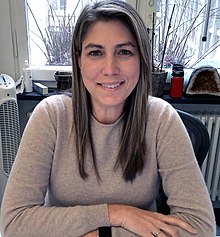This article has multiple issues. Please help
improve it or discuss these issues on the
talk page. (
Learn how and when to remove these template messages)
|

Whitney Maria Behr (born September 25, 1981) is an American earth scientist known for her contributions to understanding mechanics and kinematics of deformation in Earth's lithosphere. She was educated in the United States following which she held academic positions there. Since 2018, she has been the chair of the Structural Geology & Tectonics Group in the Geological Institute at ETH Zürich. [1] [2]
Early life, education and family
Behr was born on September 25, 1981, in Los Angeles, California, United States. Behr completed her B.S in Geology in May, 2006 at California State University, Northridge. She went on to do her doctoral studies in structural geology and active tectonics at University of Southern California under the supervision of John P. Platt.
She holds professional affiliations with the Geological Society of America, American Geophysical Union (AGU), the Earth Science Women's Network (ESWN) and Sigma Xi.
She is married, currently resides in Zürich and has a son, aged 5.
Academic career
She completed her doctoral studies in structural geology and active tectonics at University of Southern California under the supervision of John P. Platt. After receiving her PhD in 2011, she worked as a Post-Doctoral Research Fellow at the Department of Geological Sciences at Brown University under the supervision of Greg Hirth till June, 2012. From August, 2012 to June, 2018, Whitney held the post of Assistant Professor at the Jackson School of Geosciences, University of Texas at Austin. Since July, 2018, she holds the chair of the Structural Geology and Tectonics group at the Department of Earth Science in ETH Zurich.
Her primary research interests are the mechanics and kinematics of deformation in the Earth's lithosphere, rheology of the crust and upper mantle, strain localisation, rock mechanics, tectonic geomorphology, Quaternary geochronology, quantifying slip rates and earthquake hazards. Her research methodology combines field, analytical and experimental techniques to improve understanding of deformation at active and ancient plate margins. She has made contributions toward understanding the link between deformation of slow ductile flow and rapid seismogenic movements of brittle lithosphere. This helped improve understanding of seismic hazard potential. She investigated the differences between slip rates measured geodetic methods and geological slip rates. The work contributed toward understanding of intracontinental subduction zones. [3]
She has extensive field experience spanning California (Mojave desert, Coachella Valley, Klamath Mountains); Betic Cordillera in southern Spain; Syros Island in Greece; Rio Grande in New Mexico; Kenai Peninsula in Alaska; Northeastern China; Morocco in Northern Africa.
Awards and recognition
In 2019, she received the Presidential Early Career Award for Scientists and Engineers. [4] In 2016, she received the Young Scientist Award (Donath Medal) awarded by the Geological Society of America. [3] In 2013, Whitney Behr received Doris M. Curtis Outstanding Woman in Science Award for her significant contribution toward Geosciences in her PhD. [5]
References
- ^ "Whitney Behr | Structural Geology & Tectonics @ ETHZ". structuretectonics.org. Retrieved 5 March 2020.
-
^ Switzerl, Address ETH Zürich Dep of Earth Sciences Prof Dr Whitney Behr Professur Strukturgeol u Tektonik NO E. 67 Sonneggstrasse 5 8092 Zürich.
"Behr, Whitney, Prof. Dr. | ETH Zurich". erdw.ethz.ch. Retrieved 5 March 2020.
{{ cite web}}: CS1 maint: numeric names: authors list ( link) - ^ a b "Geological Society of America - 2016 Donath Medal - Whitney M. Behr". www.geosociety.org. Retrieved 5 March 2020.
- ^ "President Donald J. Trump Announces Recipients of the Presidential Early Career Award for Scientists and Engineers". whitehouse.gov. Retrieved 5 March 2020 – via National Archives.
- ^ "Whitney Behr Named Outstanding Woman in Science". www.jsg.utexas.edu. Retrieved 5 March 2020.